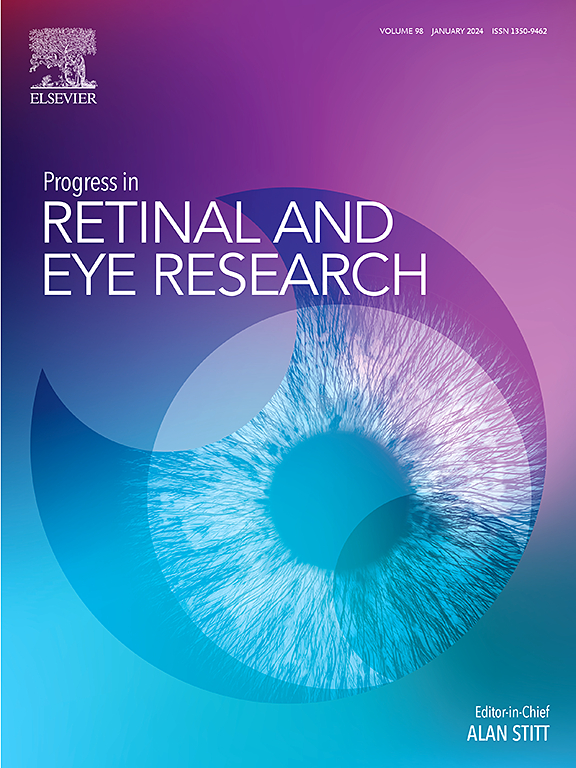评估视网膜干细胞治疗的动物模型
IF 14.7
1区 医学
Q1 OPHTHALMOLOGY
引用次数: 0
摘要
视网膜变性(RD)疾病导致严重的视力丧失,可影响负责光传导的光感受器(PRs)或为PRs提供支持的视网膜色素上皮(RPE)。基于人类多能干细胞(hPSC)的治疗是目前无法治愈的RD疾病患者视网膜结构修复的潜在方法。目前,有两种靶向hPSC治疗方法:PR挽救和PR替代。PR救援包括将RPE或其他神经祖细胞移植到视网膜下空间,以减缓或防止进一步的RD。RPE移植通过提供营养支持和维持视网膜完整性,在保护光感受器方面起着关键作用,特别是在年龄相关性黄斑变性(AMD)等疾病中。RPE移植方法的进展,如极化单层培养和基于支架的方法,已经显示出增强移植物存活和整合的希望。然而,局限性包括不一致的整合,可变的神经营养因子分泌,以及非自体移植的免疫排斥风险。在PR置换中,获得的干细胞衍生的光感受器样细胞或光感受器祖细胞(PRP)被移植到眼睛中。虽然PRP通常从视网膜类器官(ROs)中获得,但其他来源,如早期分化阶段或直接分化协议,也被用于提高PRP生成的效率和可扩展性。挑战包括实现适当的整合,形成外节段,玫瑰花结形成,以及避免免疫排斥或致瘤性。各种模拟人类RD疾病的动物模型被用于确定手术可行性、移植物存活和视觉功能恢复,但无法复制临床免疫挑战。啮齿动物模型缺乏黄斑样结构,在检测细微功能变化方面可靠性有限,而大型动物模型则面临伦理、后勤和财务方面的挑战。免疫功能低下的模型已经开发,以尽量减少异种移植物的问题。疗效的视功能测试包括光动力学测试(OKN)、视网膜电图(ERG)和视网膜和大脑的电生理记录。这些测试往往无法捕捉到人类视觉恢复的复杂性,因此需要先进的模型和改进的功能测试技术。本综述旨在汇总目前关于干细胞移植方法的知识,验证移植研究的视力益处所选择的动物模型的要求,使用特定疾病模型的优势及其局限性。虽然已经取得了可喜的进展,但解决这些限制仍然是将干细胞疗法转化为临床成功的关键。本文章由计算机程序翻译,如有差异,请以英文原文为准。
Animal models for the evaluation of retinal stem cell therapies
Retinal degeneration (RD) diseases leading to severe vision loss can affect photoreceptors (PRs) that are responsible for phototransduction, or retinal pigmented epithelium (RPE) providing support for PRs. Human pluripotent stem cell (hPSC)-based therapies are a potential approach for restoration of retinal structure in patients with currently incurable RD diseases. Currently, there are two targeted hPSC therapeutics: PR rescue and PR replacement. PR rescue involves the transplantation of RPE or other neural progenitors into the subretinal space to slow down or prevent further RD. RPE transplantation plays a critical role in preserving photoreceptors by providing trophic support and maintaining retinal integrity, particularly in diseases like age-related macular degeneration (AMD). Advances in RPE transplantation methods, such as polarized monolayer cultures and scaffold-based approaches, have shown promise in enhancing graft survival and integration. However, limitations include inconsistent integration, variable neurotrophic factor secretion, and immune rejection risks in non-autologous transplants. In PR replacement, stem cell-derived photoreceptor-like cells or photoreceptor progenitors (PRP) obtained are transplanted into the eye. While PRPs are commonly obtained from retinal organoids (ROs), alternative sources, such as early differentiation stages or direct differentiation protocols, are also utilized to enhance the efficiency and scalability of PRP generation. Challenges include achieving proper integration, forming outer segments, rosette formation, and avoiding immune rejection or tumorigenicity. Various animal models that simulate human RD diseases are being used for establishing surgical feasibility, graft survival and visual functional recovery but fail to replicate clinical immune challenges. Rodent models lack macula-like structures and have limited reliability in detecting subtle functional changes, while larger animal models pose ethical, logistical, and financial challenges. Immunocompromised models have been developed for minimizing xenograft issues. Visual functional testing for efficacy includes optokinetic testing (OKN), electroretinography (ERG), and electrophysiological recordings from the retina and brain. These tests often fail to capture the complexity of human visual recovery, highlighting the need for advanced models and improved functional testing techniques. This review aims to aggregate current knowledge about approaches to stem cell transplantation, requirements of animal models chosen for validating vision benefits of transplantation studies, advantages of using specific disease models and their limitations. While promising strides have been made, addressing these limitations remains essential for translating stem cell-based therapies into clinical success.
求助全文
通过发布文献求助,成功后即可免费获取论文全文。
去求助
来源期刊
CiteScore
34.10
自引率
5.10%
发文量
78
期刊介绍:
Progress in Retinal and Eye Research is a Reviews-only journal. By invitation, leading experts write on basic and clinical aspects of the eye in a style appealing to molecular biologists, neuroscientists and physiologists, as well as to vision researchers and ophthalmologists.
The journal covers all aspects of eye research, including topics pertaining to the retina and pigment epithelial layer, cornea, tears, lacrimal glands, aqueous humour, iris, ciliary body, trabeculum, lens, vitreous humour and diseases such as dry-eye, inflammation, keratoconus, corneal dystrophy, glaucoma and cataract.

 求助内容:
求助内容: 应助结果提醒方式:
应助结果提醒方式:


